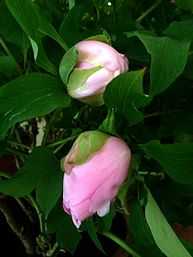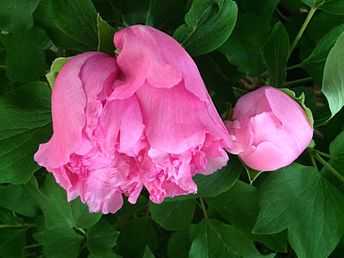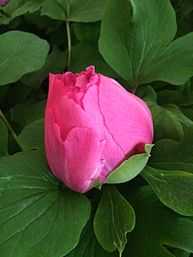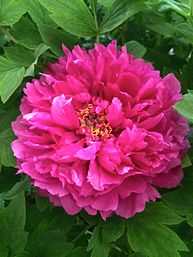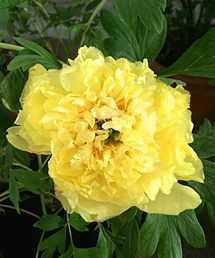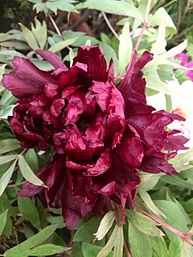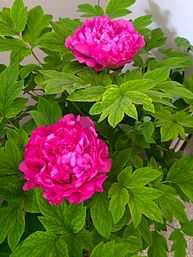Paeonia suffruticosa
| Paeonia suffruticosa | |
|---|---|
 | |
| Scientific classification | |
| Kingdom: | Plantae |
| (unranked): | Angiosperms |
| (unranked): | Eudicots |
| (unranked): | Core eudicots |
| Order: | Saxifragales |
| Family: | Paeoniaceae |
| Genus: | Paeonia |
| Species: | P. suffruticosa |
| Binomial name | |
| Paeonia suffruticosa Andrews | |
Paeonia suffruticosa, the moutan or tree peony, is a species of peony native to China. Paeonia suffruticosa is the plant’s botanical name. More commonly, the plant is referred as the tree peony.[1] It is known as mudan (牡丹) in Chinese and is an important symbol in Chinese culture. It was first described and validly published by Henry Charles Andrews in 1804.[2][3] The flower component is its most attracting feature of the plant. Paeonia suffruticosa’s flower is very large in comparison with most other flower species. The size of the flower usually ranges from 6-12 inches cross.[1] It is the flower component that is used to classify the plant’s cultivar, using characteristics such as the flower form and color.[4] The epidermis of its roots is used in traditional Chinese medicine, called "mudanpi" (牡丹皮).
Origin
Paeonia suffruticosa is a cultivated plant. Even until today, there are still uncertainties regarding which wild plants the flower is derived from.[1] The flower originates from China and its surrounding areas, possessing significant cultural meaning throughout Chinese history. Currently there are about 600 Chinese tree peony cultivars.[4] Since its introduction abroad, a few unique cultivar groups have been bred in France, Britain, the United States, and some other countries.[4] This species is less common in U.S, but it can generally be found in plant nurseries.[1]
Comparison with other peonies
Paeonia suffruticosa, also known as the tree peony, originates from China. Sometimes, people refer to these tree peonies as “Chinese tree peonies.”[5]
Paeonia suffruticosa belongs to the peony family. The most distinctive feature is that Paeonia suffruticosa is a bush or a tree, whereas most peonies are herbaceous. Despite their classification as trees, it is the flowers that attract people's attention. Peonies are generally slow to grow and have flowers that only last briefly and are fragile under weather conditions such as wind, rain or hot temperatures.[1] In comparison, Paeonia suffruticosa, as a tree, survives longer than the rest of the peonies. The woody stems of tree peonies allow the plant to survive in winter.[6] In general, the plant is long-lived, and the flowers bloom longer in the early spring.[1]
Etymology of scientific name
The name Paeonia suffruticosa is derived from two different sources. The genus name Paeonia derives from the name Paeon. In Greek mythology, Paeon was a disciple of the god of medicine, Ascleplus.[5] The species name "suffruticosa" is composed in two parts. The first part "suf-" is only a prefix; the second part "fruticosa", means shrub-like.[5]
Cultivation
In order to propagate the bush, the seeds are collected in June when the seed pods split. The pods are air-dried for a few days and are then stored in moist soil before planting out during autumn. Putting the pods into moist soil gives some moisture to the pods; If the pods are fully dried out, it is more difficult for the seeds to sprout.[1] Ideally, the plant should be planted in fertile, humus-rich soil with plenty of organic matter (in USDA zones 3 to 8).[1]
Paeonia suffruticosa grows in both full sun to dappled shade.[5] However, the plant blooms best in dappled shade with 3 to 4 hours of sunlight. When grown in full sun, it is essential to provide adequate moisture to the plant.[1] Generally, the tree requires very little pruning, but it is necessary to cut off dead branches, and to cut off any sprouts that are suckers from the herbaceous root stock.[5]
Potential cultivating diseases include Ca. Phytoplasma solani, the causal agent of the Black wood disease of grapevine. This is associated with tree peony yellows disease in China.[7]
Significance in Chinese culture
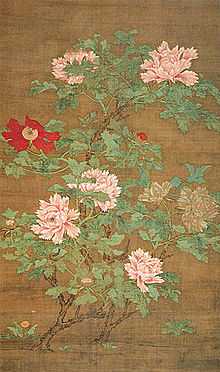
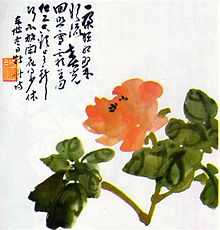
Paeonia suffruticosa has always had an important status in both Chinese politics and culture. During the Qing Dynasty (1644 -1911), the government in 1903 appointed Paeonia suffruticosa as China’s national flower.[8] However, with political shifts and other factors, its title as the national flower was later replaced. In 1929, the plum tree was granted the title of national flower by the government at the time.[8]
Despite its loss of political status, Paeonia suffruticosa maintains cultural significance. In China, it is generally known as the “king of flowers”, symbolizing honor, wealth, and aristocracy, as well as love, affection, and feminine beauty.[1] The tree peony has been frequently portrayed in significant Chinese works of literature and art.
China’s debate on the national flower
The People’s Republic of China has not yet chosen a national flower. Potential candidates include Paeonia suffruticosa, as well as plum blossom, chrysanthemum, orchid, and lotus. Paeonia suffruticosa and plum blossom are the front-runners.[9] If comparing by cultural importance, there is no one particular flower that stands out as all these flowers have been frequently portrayed in significant literatures and arts throughout the years.[8]
Elections for the national tree and flower were held in the 1980s and 1994, but both elections ended with no final conclusion.[8] Prior to the 2008 Beijing Olympics and 2010 Shanghai World Expo, Chinese government again attempted to determine a national flower. With the ongoing divided opinion over which flower should be given the national flower title, many began suggesting imitating countries such as France, Japan and Thailand by selecting two national flowers.[8] 62 scholars from the Chinese Academy of Sciences and the Chinese Academy of Engineering have proposed a “dual national flower” plan to name both Paeonia suffruticosa and plum blossom to the position.[9]
With the Olympics and Expo approaching, the ongoing uncertainty over choosing a national flower lead to the proposal The Recommendation Concerning Setting the Peony and Plum Blossom as National Flowers as Early as Possible. The proposal pointed out that the lack of a national flower is hindering the expansion of China’s flower culture and industry.[9] This proposal is only one of several potential plans; other plans include choosing one, four, and five national flowers. The five flowers suggestion, known as “One Country, Five Flowers” proposes setting Paeonia suffruticosa as the primary national flower, with four supplementary flowers that represent each season of the year. These include Chrysanthemum representing autumn, plum representing winter, orchid representing spring, and lotus representing summer.[9] Despite all these proposals, China was not able to make a decision before the Olympics and Expo. The decision remained undecided.
As medicine
Paeonia suffruticosa has a long history of being used as medicine in Chinese medicine. There are more than 1000 Chinese tree peony cultivars with various kind of flower colors and flower forms that have been selected artificially for medicinal uses for more than 2000 years.[4] The root bark, often referred as Mu Dan Pi or Cortex Moutan, is the main part that is used in Chinese medicine. Mu Dan Pi’s main functions include clears heat, cools blood, clears fire from deficiency, clears ascending Liver fire, and mildly invigorates the blood.[1] Mu Dan Pi that has best quality should be very fragrant, and is thick, white and starchy.[1] The flower is now mostly cultivated for medical uses. Due to over-harvesting, the wild plant is threatened with extinction.[1]
Chemistry
P. suffruticosa contains paeonol, galloyl-paeoniflorin, galloyl-oxypaeoniflorin, suffruticoside A, B, C, D and E.[10]
Gallery
References
- ↑ 1.0 1.1 1.2 1.3 1.4 1.5 1.6 1.7 1.8 1.9 1.10 1.11 1.12 "Jade Institute" Jade Institute. "MuDanPi." Jade Institute. Retrieved 5 March 2014.
- ↑ International Organization for Plant Information (IOPI). "Plant Name Search Results" (HTML). International Plant Names Index. Retrieved 13 August 2009.
- ↑ Paeonia suffruticosa in the Flora of China eFloras.org. Accessed online: 13 August 2009.
- ↑ 4.0 4.1 4.2 4.3 "Hort Science" Applicability of Leaf Morphology and Intersimple Sequence Repeat Markers in Classification of Tree Peony. Suo, Zhi-Li, Wen-ying Li, Juan Yao, Hui-jin Zhang, Zhi-ming Zhang, and Di-xuan Zhao.Hort Science 40 (2005). Retrieved 5 March 2014.
- ↑ 5.0 5.1 5.2 5.3 5.4 "Tree Peonies" Tree Peonies. David Beaulieu. About.com Landscaping. Retrieved 5 March 2014.
- ↑ "Paeonia Suffruticosa" Missouri Botanical Garden. "Paeonia suffruticosa - Plant Finder." Missouri Botanical Garden. Retrieved 5 March 2014.
- ↑ Identification of ‘Candidatus Phytoplasma solani’ Associated with Tree Peony Yellows Disease in China. Ying Gao, Ping-Ping Qiu, Wen-Hao Liu, Wen-Min Su, Shu-Peng Gai, Yuan-Cun Liang and Xiao-Ping Zhu, Journal of Phytopathology, March 2013, Volume 161, Issue 3, pages 197–200, doi:10.1111/jph.12025
- ↑ 8.0 8.1 8.2 8.3 8.4 "National Flower, Tree, Bird to be Chose" China Daily. "Environment." National Flower, Tree, Bird to Be Chosen. Retrieved 5 March 2014.
- ↑ 9.0 9.1 9.2 9.3 "Debate over China's national flower" "Chinese media, advertising, and urban life." Joel Martinsen. Debate over China's national flower. Retrieved 5 March 2014.
- ↑ Yoshikawa, M.; Uchida, E.; Kawaguchi, A.; Kitagawa, I.; Yamahara, J. (1992). "Galloyl-oxypaeoniflorin, suffruticosides A, B, C, and D, five new antioxidative glycosides, and suffruticoside E, A paeonol glycoside, from Chinese moutan cortex". Chemical & pharmaceutical bulletin 40 (8): 2248–2250. doi:10.1248/cpb.40.2248. PMID 1423794.
External links
![]() Media related to Paeonia suffruticosa at Wikimedia Commons
Media related to Paeonia suffruticosa at Wikimedia Commons

